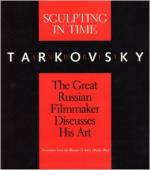|
This section contains 473 words (approx. 2 pages at 400 words per page) |

|
Chapter VII Summary and Analysis
Film is an emotional reality. The director-artist is capable of creating his own world. It is also an "immediate" art form, like music, in that it can be directly perceived. By contrast, literature conveys meaning through symbols, the words on the paper.
Because cinema is so similar to reality—unlike a painting, which can be said to be "life-like" but would never be mistaken for real people doing real things—cinema is particularly capable of evoking emotion and otherwise affecting people. It can be used for escapism and entertainment as well as spiritual enlightenment. Because of this power, filmmakers have a responsibility to the audience. "Artistic freedom" is a bit of an oxymoron, because the artist is never free; he is beholden to his community.
Tarkovsky estimates that eighty percent of a cinema audience is there for...
(read more from the Chapter VII Summary)
|
This section contains 473 words (approx. 2 pages at 400 words per page) |

|




